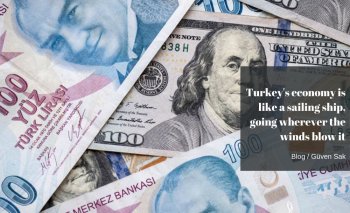Commentaries
Fatih Özatay, PhD - [Archive]
Getting a clear signal in all the noise 29/11/2012 - Viewed 1699 times
Abundance of data sometimes causes a lot of “noise.” And it is a difficult task to get a clear signal in the noise.
Turkey used to be an absolutely “data-poor” country, particularly concerning growth statistics. The statistical institute released only annual GDP growth statistics and monthly figures were limited to electricity production or cement production figures. We used to hear statements like “cement production increased this much during the first year of our government” and prospective surveys were completely missing.
I started writing my PhD dissertation in 1981. A major part of the study focused on identifying “leading indicators” that can predict the changes in the economic activity. Given the task, annual statistics were of no use. So I developed a monthly “industrial output index” using monthly output figures for electricity, cement, iron-steel, tobacco and alcoholic beverages sectors. Later when I started working at the Central Bank Research Department, I worked with two colleagues (Lerzan İskenderoğlu and Melike Altınkemer) to enrich the index (Industrial Output Index, Central Bank Quarterly Bulletin, III, 1988).
Back then the Research Department was headed by Hasan Ersel. He asked us to develop a macroeconometric model that uses quarterly statistics to make prospective estimations. And, let me tell you that he is not someone you can hum and haw to. Anything he asked you to do turns out to be reasonable in the end no matter how hard it seems in the first glance. Anyway, we started striving to derive quarterly figures using annual GDP figures. For instance, using the monthly industrial output index I mentioned above with the help of certain technical methods we derived quarterly industrial value added figures. We used the number of cars that used the Bosporus Bridge in a month as an indicator of the value added in the transportation sector and so on. In the end, we had a quarterly GDP series for both output and consumption sides. Besides, the series included sub-components on consumption, investment and industrial value added. I still regret that we did not develop an academic article out of this study which was a first in the field in Turkey but released just the model and the results.
I am talking about 2-3 years of work and a period when you used ‘64K computers’ (during my dissertation period) and had to draw graphs manually (later at the Central Bank, we used a device holding 6 pens of different color with it mechanical pens. You connected this device to the computer and it drew the graph on paper in a very long time).
Abundance of data
And look where we are today, enjoying ample sources of data from daily to quarterly and all. If we had is in the 1980s, I could have spent those two years for specializing in another field. Anyway, I hope that those studies were of some use. But are those “swimming” in the pool of data aware of this spectacular advancement?
Yet, more isn’t always better. Abundance of data sometimes causes a lot of “noise.” It is a difficult task to get a clear signal in the noise and no one seems to make such effort. Sometimes when I read comments on the latest figures, I hardly manage keeping calm. I will give some examples on industrial output, capacity utilization ratio and real sector confidence index.
This commentary was published in Radikal daily on 29.11.2012














